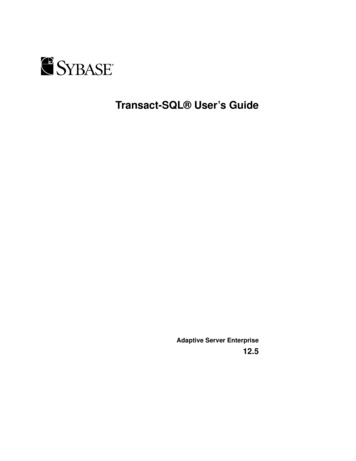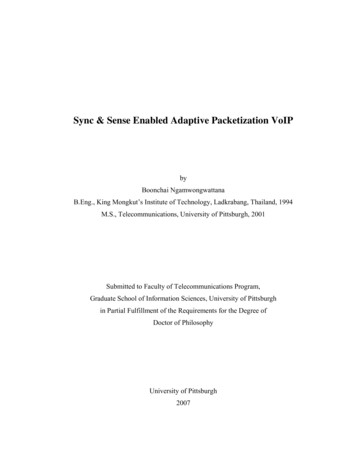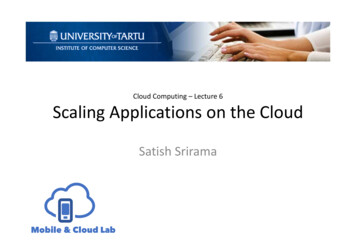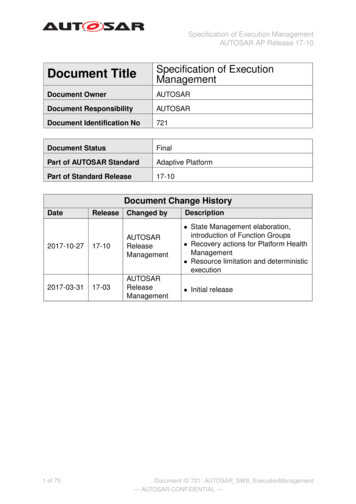
Transcription
An Extensible and Adaptive Framework for Load Balancing usingMulticastingJens VestiChristian Theil HaveIT University, Copenhagen{vesti,cth}@itu.dkSupervisor: Kåre Jelling KristoffersenJanuary 16, 2004AbstractVarious load balancing solutions are available today. Most of these sufferfrom several issues such as single point of failure or merely the high pricesthat comes with specialised and proprietary solutions. We propose and implement a framework for load balancing solutions that eliminates the singlepoint of failure. The framework is flexible and enables programmers to adaptthe load balancing to the exact requirements a such may have. The framework enables the programmer to create single system image clusters, whichto the outside world looks like a single host. We use multicasting in order to distribute the packets to all cluster hosts. These are hereafter filteredon each cluster such that only one host ends up receiving the packet. Theframework is tested and demonstrated using two example modules. The testsperformed proves the concept and shows a performance advantage of usingthe framework.
Contents1 Introduction1.1 Motivation1.2 Aims . . . .1.3 Methods . .1.4 Overview .2 Basic Terminology2.1 Scaling . . . . . . . . . . . . . . . . . .2.1.1 Hardware scale-up . . . . . . .2.1.2 Software scale-up . . . . . . . .2.1.3 Scale-out . . . . . . . . . . . .2.2 Fault Tolerance . . . . . . . . . . . . .2.2.1 Reliability and Availability . .2.2.2 Failures, Errors and Faults . .2.3 Group Communication . . . . . . . . .2.3.1 Group Structure . . . . . . . .2.3.2 Group Membership . . . . . . .2.3.3 Message Delivery and Response2.3.4 Group Addressing . . . . . . . . . . . . . . . . . . . . . . . . . . . . . . . . . . . . . . . . . . . . . . . . . . . . . . . . .Semantics. . . . . .3 Related Work3.1 DNS Round Robin . . . . . . . . . . . .3.2 ONE-IP . . . . . . . . . . . . . . . . . .3.3 Clone Cluster . . . . . . . . . . . . . . .3.4 Microsoft’s NLB and WLBS . . . . . . .3.5 Distributed Packet Rewriting . . . . . .3.6 Common Address Redundancy Protocol3.7 Summary . . . . . . . . . . . . . . . . .4 Problem Statement4.1 Approach . . . . . . . . . .4.2 Flexibility . . . . . . . . . .4.3 Platform . . . . . . . . . . .4.4 Performance and scalability4.5 Limitations . . . . . . . . .11111.2223344555677.9991112141516.1617171717185 Load Balancing Framework Architecture185.1 Netfilter . . . . . . . . . . . . . . . . . . . . . . . . . . . . . . . . . . . . . . . . . . . 195.2 Conceptual model . . . . . . . . . . . . . . . . . . . . . . . . . . . . . . . . . . . . . 19ii
5.35.45.55.6Kernel modules . . . . . . . . .Extensibility of our frameworkKernel vs. user space . . . . . .Connection tracking . . . . . .6 Implementation6.1 Browsing the source . . . . . . . . . . . .6.2 The main kernel module . . . . . . . . . .6.2.1 ARP handling . . . . . . . . . . .6.2.2 IP packet handling . . . . . . . . .6.2.3 Compile time parameters . . . . .6.3 Userspace . . . . . . . . . . . . . . . . . .6.4 Writing load balancing extension modules6.4.1 Example: simple hash . . . . . . .6.4.2 Modules written in C . . . . .7 Evaluation and Test7.1 Issues when testing . . . . .7.2 Testbed and test description7.3 Userspace tests . . . . . . .7.4 Kernel space tests . . . . .7.5 Evaluation on tests . . . . .20202121.22222323242424252526.2727272829298 Summary and Future Work30References31A Load Balancing Algorithms and Approaches Used34A.1 The simple hash algorithm . . . . . . . . . . . . . . . . . . . . . . . . . . . . . . . . . 34A.2 Neighbour surveillance algorithm . . . . . . . . . . . . . . . . . . . . . . . . . . . . . 34iii
11.1IntroductionMotivationE-systems and web-services in general have become popular over the last decade. For somecompanies and organisations it has proven to be a major problem keeping up with the demand Cardellini states in [CCCY02] that the number of online users is increasing with 90 percent perannum. If a system proves to be popular the number may even increase more than 90 percent. Itis therefore essential to keep up with the demand in order to continuously provide quality service.As the demand for web-services increase, so does the requirements to the server-side technology responsible for running and delivering these web-services. Furthermore, the computationalimplications of running such services has increased. Content are dynamically created by programs,often communicating with other systems. Large scale web-services does not run on a single serveranymore, they run expensive platforms that include web servers, database servers and applicationservers etc.There is a variety of techniques for scaling web-services to meet the demands. Our focus is onthe techniques that distribute requests to several servers. Common for the solutions in this area isthat they are not that flexible when it comes to handling different kinds of requests or adapt therequirements of the organisations. Some organisations require a fault-tolerant web service whileother kinds of web requests require a fast, but not necessarily a fault-tolerant, service.1.2AimsThe intention of this report is to present the work done in creating a flexible and extensibleframework for implementing load balancing algorithms. To justify the need of such a frameworkwe try to give the reader a brief understanding of the problems in the field of scaling and loadbalancing. We introduce the existing solutions and current research in this area along with theissues these may have.1.3MethodsThe work in this report will be carried out with respect to the principles of experimental computer science and in particular the proof-of-concept and to some extend the proof-of-performance[SBC 94]. Using the proof-of-concept we can demonstrate a concept by assembling a number ofwell known techniques and tools in a new form in order to fulfill a new purpose or set of objectives.The proof-of-performance can be used to evaluate a given phenomena, such as any of those usedto assemble the concept we wish to prove.1.4OverviewThe approach in this report is first to describe the basic terminology used in this field of studyand research. We do this in order to create a common understanding and foundation for the restof the report.1
Secondly we briefly review the related load balancing techniques and proprietary and nonproprietary solutions available today. This is done as we wish to get an understanding of the issuesassociated with these.Derived from the brief review we hereafter present the problem statement and the architectureof our solution, and finally the implementation and evaluation.2Basic TerminologyThere is a number of basic concepts and terms that need to be understood in order to comprehend the issues and solutions given in this report. We will in the following describe these basicconcepts and terms briefly, and where relevant, the issues related to these.2.1ScalingScaling means in general to adapt something to a given scale. In the case of scaling web serverswe adapt the size of the servers to the load expected. Scaling a web service can be done in variousways. In this section we will in general terms present the techniques available, how they work,what the benefits and limitations are. We do this in order to get an understanding of where oursolution fits into the greater picture. In Figure 1 is depicted an overview of the different disciplinesin scaling Web server systems. The figure which was originally presented in [CCCY02] shows anumber of boxes each representing a scaling technique or a superset of scaling techniques. Eachscaling technique is described in details in the following sections.Figure 1: Scaling techniques in Web-systems [CCCY02]2.1.1Hardware scale-upChanging and upgrading the hardware is referred to as a hardware scale-up [DGLS99, CCCY02].This approach is often one of the first techniques to apply when scaling the system. Obviously there2
is a limit to how often this approach can be taken as the increase in computational power of a singleserver is low, compared to the number of online users which in average is increasing with 90% perannum [CCCY02]. Given these figures, hardware must be changed on a regular basis when thisapproach is being used. Some providers may lease the hardware in which case a hardware scale-upis relatively cheap. But in the case of a company owning the hardware the replaced hardware ismade redundant unless there is another place for it in the company or a scale-out approach is beingtaken as described in Section 2.1.3.2.1.2Software scale-upUpgrading or changing the software in order to achieve improved performance is often calleda software scale-up [CCCY02]. The term software covers in this case operating systems, Webservers (eg. Apache or Microsoft IIS), databases, and services developed in-house etc. Just as withhardware scale-ups there is a limit to how often this can be done. This because of the limitedpossibilities of changing software and the costs of doing this. It is however a better solution overtime, compared to a hardware scale-up, as the changes may follow whatever other scaling techniquesbeing used later on. It does however often only scale on a smaller basis, depending on the servicebeing scaled. If well designed and optimised services, such as operating systems and Web servers,are being upgraded the system cannot be expected to scale-up well. On the other hand if poorlydeveloped services are upgraded it may very well scale very well.2.1.3Scale-outClustering is an interesting area that has much research focus. The technique is also calleda scale-out and means in general expansion of capabilities by adding nodes [DGLS99, CCCY02].This implies that the system is distributed or replicated over several hosts in order to provide highavailability and performance. The term scale-out can furthermore be split up into a local and globalscale-out.Local scale-out is when the hosts are kept within the same network on the same geographicallocation. Cardellini et al identifies three types of Web cluster systems in [CCCY02]. With clusterwe mean a group of servers that cooperate to act in a transparent way as a single identity to aclient.1. The cluster based Web system has a routing or load balancing device in front of the clusterto distribute to traffic to each cluster host. The cluster hosts are transparent to the client asthey cannot see the IP address of each host but only the front-end devices.2. The virtual Web cluster, first given in [CCCY02], covers clusters where the virtual IP addressis the only visible address to the clients. This approach is particularly interesting becauseit has the ability to remove the single point of failure, that is common for most scale-outtechniques, by moving the dispatching to the cluster hosts themselves instead of using a dedicated load balancing switch. It is furthermore interesting because the group communication3
used is suitable for fault tolerance in terms of availability and to some extend reliability. Avirtual Web cluster is a stand-alone cluster that works independently and with no front-endnode to act as a dispatcher, that is the node who makes decisions whom to hand out thepackets. This approach is a subset of layer four switching with layer two packet forwardingdescribed in [SSB00]. The research in this area is sparse and limited to a handful of articlesand technical reports [VC01, nlb00, Gre00, wlb99, CCCY02, SSB00, DCH 97]. We will inSection 3 review the research done in particular this area.3. The distributed Web systems are some of the oldest cluster based Web systems. The dispatching is done outside the cluster which makes each host within in the cluster visible to theclient. An example is the DNS Round Robin (DNSRR) solution described in Section 3.1. Thedispatching granularity is very coarse and various issues in this approach has been identified[STA01].Global scale-out is when cluster hosts are spread out over multiple geographically distant locations. This concept can be used whenever local scale-out is not longer sufficient because of a singlelocation becoming a bottleneck [CCC01]. Global distributed clusters usually dispatches the loadon different levels. Most commonly is coarse grained dispatching on DNS level using eg DNSRRdescribed in Section 3.1 and fine grained on the Web cluster level using same methods as in localscale-out solutions [CCC01].Other solutions may be used. One of the interesting methods is using the group addressingparadigm anycasting presented in Section 2.3.4 which makes the use of global scale-out techniquestransparent.2.2Fault ToleranceOne of the issues today with Web services are the numerous failures a client may experience.The reason for these failures are many, ranging from software failures to hardware failures andagain to a simple lack of performance. What is needed to avoid these failures, and what is beingprovided, to some extend, using various solutions, as those discussed in Section 3, is fault tolerance.Fault tolerance is simply a way to incorporate redundancy to mask failures in the system [Jal98].This can be done in various ways and on different levels. We will in the following describe the centralterminology that relates to our focus in this report.2.2.1Reliability and AvailabilityReliability and availability is often mistaken or used interchangeable, but do in fact have differentmeanings. Reliability can be expressed as the probability of the system still working at a given timein the future. Often reliability is presented as mean time to failure. Availability can be expressedas how often the system is available. This can be presented in percentage for example as up-timeor down-time. It should be mentioned here that availability is different from reliability in the sensethat a system can be highly available but erroneous, that is, not reliable. One way to go for higher4
availability and reliability is replication. By replicating the services, one service may take overwhen another one fails.2.2.2Failures, Errors and FaultsThere are several reasons why the system may be unreliable or unavailable. In order to fullyunderstand how we can improve reliability and availability we first need to identify and get anunderstanding of what causes these conditions.The terms failure, error and faults are often mistaken for one another but they do have differentmeanings. Failures occurs when the service does not behave as specified [Cri91b]. Failures can besaid to be the outcome of errors and errors occur because of faults.Failures in particular can be classified into following groups [Cri91b].Omission failures happen when a service omits to respond to a specific input.Timing failures occur when the right response is received but with the incorrect timing. Thiscan be either as an early or late timing failure, that is the response can arrive earlier thanexpected or later.Response failures are responses that do not match the expected result. This can either be interms of value failures or in state transition failures.Crash failures occur when the service does not respond to the requests until it has beenrestarted. The first failure occurring would be seen as an omission failure as it is a singlefailure, whereas the succeeding failures are crash failures. Depending on the state the serviceis in when it restarts we can further classify the crash failure into amnesia-crash where theservice returns to a predefined state, partial-amnesia-crash where parts of the state beforethe crash is kept, pause-crash where the service restarts with the state the service had beforethe crash, and halting-crash where the service never restarts.2.3Group CommunicationBecause group communication is one of the central topics here it is ideal to shortly introducethe basic concepts.2.3.1Group StructureThere are two categories of systems supporting group communication, the open groups and theclosed groups [Tan95]. Open groups permit any process to send to the group, including processesthat are not members of the group. With closed groups only processes which are members of thegroup can send to the group, and non-members cannot. Whether groups should be closed or opendepends on the purpose of the system.5
2.3.2Group MembershipThere are two types of group membership, the static and the dynamic membership [Tan95,KT92]. This is relevant in relation to what we are trying to accomplish here because membershiphandling can be complex to handle. It must be done on the fly, that is it must be transparent tothe client, he cannot notice delays or denial of service while the membership state is changing.Static membership is the simplest form of membership to manage of the two types. By static wemean that it is not possible to change the state of the group as long as the group exists. Changingthe state means to let processes join or leave the group. Most systems, however, do need to changetheir state over time, although most slowly and rarely [Bir96].In contrast to a static membership we have the dynamic membership where processes may joinand leave the group whenever they choose. This gives us a group that also shrinks with failures aswell as grows with joins [Cri91a]. The complexity in handling this kind of group is high as a failedprocess per definition has left the group, but cannot signal this information because it has alreadyfailed. There are three ways of handling this complexity and keep group membership informationupdated in the group as described in [Cri91a], which is presented in a simplified way below.Periodic broadcast membership. All processes broadcast when they are willing to join thegroup, just as they keep broadcasting messages telling the group that the member is stillpresent. We will refer to these as heartbeat messages [ACT97]. In the absence of one orseveral heartbeat messages the group can presume that the member has left the group. Theproblem with this approach is the number of broadcasts being sent with a fixed time intervalmay flood the network. Another issue is whether the broadcast can be considered a reliableform of communication. If some broadcasts do not arrive in time at destination, or at all, itmay be difficult to tell whether the process has left the group or not.Attendance list membership. A process may join the group in the same way as with periodicbroadcast membership, but after joining the group state is maintained passing an attendancelist around a virtual ring. If a process fails it will be noticed when relaying the list amongthe members.Neighbor surveillance. This approach works in the same way as the above described approaches, except the way failures are detected. A neighbor is being monitored by its successor, and in the case of failure a regroup message is being broadcast.For all the approaches described above applies the regroup message meaning that in the case ofa process leaving the group, eg because of a failure, the group must reorganise.6
2.3.3Message Delivery and Response SemanticsThere are four message delivery semantics we need to address [KT92]:1. Single delivery semantics is used when only one of the group members are required to receivethe message.2. k-delivery is used when at least k members of the group must receive the message.3. Quorum delivery is when the majority of the group receives the message.4. Atomic delivery is the most difficult to manage as all hosts within the group requires toreceive the message.There are five categories of response semantics [KT92]:1. No response is when no response is sent back to a message request. This implies an unreliablecommunication.2. Single response is when exactly one host within the group responds to a request.3. k-responses is when k responses are sent back from the group.4. Majority response is when a majority of the group hosts responds to a request.5. Total response is when all hosts in the group must respond to the message received.When we use the term group we mean the current group.2.3.4Group AddressingThe different group addressing paradigms used here are relevant in order to understand howfault tolerance is provided in Web cluster systems. We will in this section describe the terms uni-,broad-, multi- and anycasting in relation to Web system clustering and fault tolerance.Unicasting is a one-to-one communication paradigm which in our case relates poorly to ourproject in terms of reliability as it is costly to address multiple servers at once in order to providereplication.Broadcasting is a way of addressing all hosts on the network, it is a so called one-to-all orall-to-all message approach. It is in general unreliable because of the possibilities of receive andomission failures but is often sufficient [Bir96]. The problem with broadcasting is that not all hostson the network may be interested in the message sent, but they receive everything anyway. This is7
an overhead that can be avoided using the multicast approach described next.Multicasting is a way of addressing, and delivering datagram by best effort to several hosts onthe network, it is therefore a one-to-many approach. The way it works is that a multicast addressis specified and messages sent to this address is being received by those subscribing or listening toit. As with broadcasting, unreliable delivery is often sufficient. There is however heavy researchdone in the area of reliable multicasting.Anycasting has the purpose of delivering, by best effort, an anycast datagram to at least onehost, and preferable no more than one host within the group as originally described in [PMM93].So it is fair to say that anycasting is a one-to-any communication paradigm. The way anycastingis intended to work on the Internet is that hosts who wishes to join an anycast group registersthemselves as being members of this group. Then whenever a client sends out a datagram destinedfor an anycast group a decision on to which group member the datagram should be sent to is taken.This approach is interesting in terms of a webserver global scale-out. Depending on which algorithm is used to find the group member and forward the datagram to, it is useful to locate resources,and as every packet forwarding need a lookup in the routing table the problems experienced withDNSRR, as described in Section 3.1 are not present here.In contrast to multicast addresses in IP version 4 and 6, the anycast addresses are indistinguishable from unicast addresses. It is transparent to the client, and the communication can be donejust as with unicasting.The downside to anycasting is that it is stateless, and therefore connectionless. The originalspecification [PMM93] and the IPv6 specified in [DH95] describes a method to create a statefulconnection using TCP. Basically a client tries to establish a connection to an anycast server whichchanges the address from an anycast to the unicast address of the server.Other limitations that need addressing would be the high communication costs between members within the anycast group when distributed over at slow WAN in comparison to a fast LAN.This would effectively mean less communication across the WAN and make the group inflexible.This issue naturally depends of the nature of the service provided. If the need of up to date redundancy is not high the communication between the anycast group members therefore can beproportional lower.Most research in anycasting has been focused on the network layer, which does not apply foranycasting on a LAN. A proposal in [BEH 97] describes a method of addressing a single host in theLAN. It basically sends out an ARP request to retrieve the physical address of one of the anycastgroup members. The first to reply is the host to forward the datagram to. This technique isinsufficient as all subsequent datagram all are sent to that member and none to the other members.8
3Related WorkThere is limited research done relating to what is the intention of this project. In this sectionwe will survey some of the research projects that have been carried out. The survey will reflectthe topics presented in Section 2.3 and 2.2. The main focus is on virtual Web cluster systems asthese have a potential to be more reliable and available that other scaling techniques as presentedin Section 2.1.3.3.1DNS Round RobinDNSRR is presented in RFC 1794 [Bri95] in 1995 and was one of the first load balancingmechanisms used. It expands the original design of the DNS which is to look up and translatedomain names into IP addresses. The DNSRR load balances by holding a list of IP addresses forthe same domain name and resolve the domain names in a round robin fashion, that is, the IPaddress resolved is not the same for every lookup [KMR95].There are several issues in using DNSRR. One of the most critical is the caching of addresses.Caching occurs in the routers and the clients using the domain name. This implies that when amember of the group leaves, for example in the case of a crash failure, changes in the group state donot necessarily propagate throughout the network immediately. Furthermore, in such a situationthere is not mechanism to mask the failure. The level of reliability and availability is therefore low.Another issue is that DNSRR does not provide true load balancing, that is, the mechanismdoes not take into consideration the load and the resources available of a server. The load is, whenoptimal balanced, equally balanced between all hosts regardless resources.3.2ONE-IPOne of the first virtual Web clusters was the ONE-IP originally developed at Bell Laboratories[DCH 97, WDC 97]. The purpose of this research project was to be able to address a cluster witha single IP address image. The project uses two methods of solving the problem, the dispatchingmethod and the broadcast method. We will in the following describe the two methods.The dispatching method is a hierarchical, open client-server group as any client can send to thegroup through the dedicated dispatcher which is controlling the group members load by dispatchingthe connections to the cluster hosts. A cluster of hosts has a common IP address, what we call acluster address1 . This approach is depicted in Figure 2.The broadcast method is a peer and open client-server group as there is no dedicated dispatcherto control the load of the group members. Just as with the dispatching method a cluster address isidentifying the cluster. The router is receiving the packet, determines whom to forward the packet,and broadcasts it on the network using Ethernet broadcasting. Each cluster host has a filter that1For consistency purposes we chose to keep to the same terms in this report rather than adopting terminologyfrom each technology as we go along9
Figure 2: The dispatching approach in ONE-IPfilters packets meant for other hosts. The filtering rule is created using a unique number that eachcluster host is assigned. This implies that only one group member receives the packet. As a hostsending out the message we do not care who receives the message. It is therefore fair to say thatthis is an anycast simulated using broadcasting and filtering techniques. This approach is depictedin Figure 3.Figure 3: The broadcasting approach in ONE-IPThe membership is static for both methods as the unique number is statically assigned andcannot be changed once the cluster is running. This makes the solution less useful in the case ofa crash failure where no other members are able to take over for the failed group member. There10
are in general no techniques used to mask failures what so ever.This architecture is good in the way that packets are filtered at the lower layers based on thefiltering rule described. The packets are sent directly back to the client and not through the routerwhich reduces the overhead of forwarding packets. However, by introducing a dedicated server todistribute the load, a single point of failure is introduced.Using broadcasting all hosts within the network will receive the packets. This is an overheadworth noticing because all members as well as non-members on the same Ethernet segment, exceptthe one which the packets are intended, will spend resources filtering the packets. This may howevernot be a problem as the cluster should run on a dedicated network in order to avoid unnecessarycommunication to take up bandwidth.3.3Clone ClusterIn the Cluster Clone approach Vaidya and Christensen extends the ONE-IP approach describedin Section 3.2 by eliminating the dedicated server distributing the packets [VC01]. This is achievedusing Ethernet multicast to deliver the packets to each cloned cluster host (hence the ”clusterclone”). A cloned cluster host is basically a host that is an exact copy of another host. This can beachieved
requirements of the organisations. Some organisations require a fault-tolerant web service while other kinds of web requests require a fast, but not necessarily a fault-tolerant, service. 1.2 Aims The intention of this report is to present the work done in creating a flexible and extensible framework for implementing load balancing algorithms.










